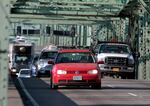Washington lawmakers are poised to set aside $1 billion to replace the Interstate 5 bridge at the Oregon border, making good on a pledge to make the first overtures after killing the last replacement proposal almost a decade ago.
The allotment is part of a larger, nearly $17 billion transportation package that lawmakers have been negotiating for months. Documents showing what is likely to be the final framework of the package became public Wednesday.
The package must still go to a vote in the Washington Legislature and garner Gov. Jay Inslee’s signature, but officials in Southwest Washington and in Oregon are excited. If passed, it will be a major milestone to replace the century-old bridge that has the potential to collapse during a major earthquake.
“It has been a long road to restarting the new effort to replace the I-5 bridge,” said Sen. Annette Cleveland, D-Vancouver, noting that discussions to replace the bridge date as far back as the 1980s when she was a legislative aide.
“I feel pleased to have reached this milestone and look forward to the work ahead focused on breaking ground in 2025,” she added.

FILE - In this Aug. 4, 2011, file photo, taken in Portland, Ore., traffic crosses the Interstate 5 bridge spanning the Columbia River between Oregon and Washington.
Don Ryan / AP
Washington’s allotment is slightly less than anticipated. Plans had been in place for the state to give $200 million more. Cleveland attributed the shortfall to the lass-minute scramble to rewrite some of the package, after a controversial export tax idea went up in smoke.
“So, the project had to be adjusted downward,” Cleveland said in a text message.
Replacing the bridge has an estimated price tag between $3.2 billion and $4.8 billion. Washington’s piece is part of three-pronged funding plan, with money from Oregon and the federal government also expected to cover the cost.
Oregon lawmakers working closely on the replacement couldn’t say how they intend to come up with their portion. While lawmakers in Salem adjourned last weekend and won’t convene again until 2023, they said they are ready.
“This says, ‘Oregon, it’s your turn. It’s your time,’” said Rep. Susan McLain, D-Hillsboro. “Washington has started this process and now it’s important for us to make a commitment.”
Oregon passed a transportation package as recently as 2017. Meanwhile, tolls have been a common, yet controversial, question that remains on how to pay for the bridge.
Once both states are at the table, they hope to avail themselves to an unprecedented amount of federal money. The U.S. government’s $1.2 trillion infrastructure package, which passed in January, earmarks about $40 billion for bridges.
In Vancouver, where the bridge spans into Washington, Mayor Anne McEnerny-Ogle likened the impending legislative vote to a field goal kick still in the air, sailing toward the goal post but not yet through. She called it a “nail biter.”
“When you’re building something like this, it’s like building the Bonneville Dam,” she said.
That Washington lawmakers would lay down the first dollars has been an understood, if informal, agreement between them and their peers in Oregon, after an infamous fallout the last time they attempted to replace the bridge.
In 2013, after years of planning the project known as the Columbia River Crossing, the Washington State Senate refused to pass a funding package to replace the bridge.
“We felt kind of left at the gate,” McLain said. “We worked really diligently to get our package together, and yet this time they’re going first. They want to show us they’re serious.”
Plans then went dormant, but the need has persisted. The bridge is a major bottleneck for interstate travel on the West Coast. In 2019, more than 143,000 vehicles crossed the bridge daily, according to Washington and Oregon’s departments of transportation.
While Washington’s funding is an important milepost for the project, officials said, there are many miles to travel.
According to Rep. Sharon Wylie, D-Vancouver, plans will now ramp-up to initiate final decisions on other important aspects of the bridge. Questions linger, such as if it will be a double-decker bridge, how many lanes it may have, how it will connect to Hayden Island and what kind of mass transit options it may include.
Staff with the Interstate Bridge Replacement Project, an administrative team jointly run by the two states’ departments of transportation, have also been fielding community input about potential impacts of a major bridge overhaul.
“We’re going to have to be in a pretty positive place in order to leverage the federal dollars to finish the job,” Wylie said.

